Oh, Ethel Wright. How difficult could it be? She has some cracking pictures and even some photos, and a Wikipedia page! Piece of cake.
Except there is so much information and it's contradictory and it leaves so much out. I'm committed now (or I very soon will be) so let's meet (or not meet) Ethel (if that is even her name) together...
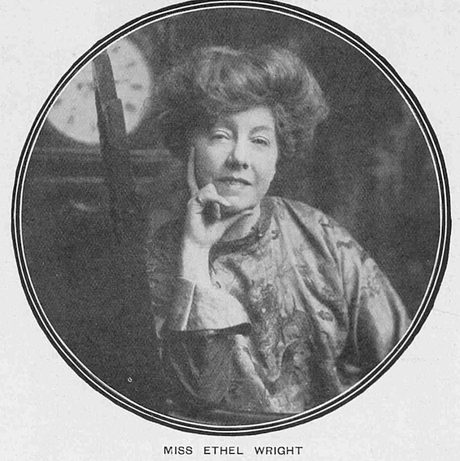
Let's start with the fact that her name isn't Ethel. I'm not sure why Miss Caroline Elizabeth Wright decided to go by Ethel, but what really got me puzzled was that there is more than one Caroline Elizabeth Wright all born around the same time and going by the various accounts of Ethel online, I think there has been a fair amount of confusion. I am particularly grateful to this page as it backed up a lot of what I was puzzled about which was reassuring. An awful lot of accounts give her date of birth as 1872, but she seems to have started exhibiting in 1888 so either she was a child prodigy or she actually the Caroline Elizabeth Wright who was born in 1866. As she took another name, I wondered if her mother was actually called Caroline and Ethel became a pet name (as we have seen elsewhere). There was actually a John and Caroline Wright who baptised their daughter Caroline Elizabeth in London in 1866, so that might be them. Some people claim Ethel was born in Liverpool, and it is true she was married there later on, but some claim she was born in London, which would make sense of the training she claims to have had. If I had all the time in the world I would go through the census, travel and hatch, match and despatch records with a fine-tooth comb, but we only have today, so let's see where it takes us.
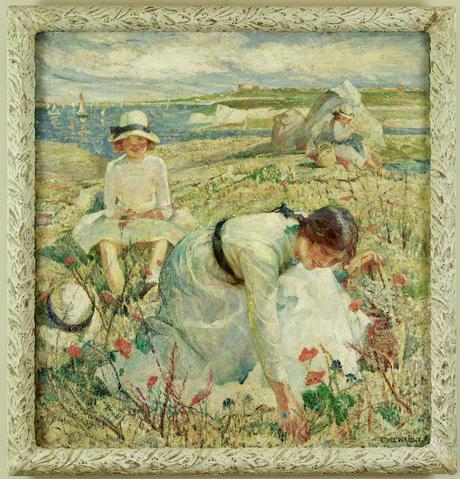
Picking Flowers on a Cliff Top (undated)
We have one source which is about as trustworthy (and possibly untrustworthy) as they come and that is Ethel herself. She was a bit of a superstar in her time, with quite the spread in Tatler, entitled 'People I have Painted' published in 1908. In it she talked about learning to paint at a young age but a chance meeting with Solomon J Solomon sent her to Paris - 'to have all the nonsense taken out of me.' She studied drawing and painting at the Academie Julien, working really hard but, as she described, having a smashing time. Travelling to the Latin Quarter, she visited other students and artists in their studios, remembering especially the studios and dinner given by Dudley Hardy and George Frampton, who would model vases for the dinner table - 'I often wish I had kept some of these early examples of Mr Frampton's work.'
When Ethel came back to London, she spent some time in the studio of Solomon J Solomon and studying under him at Cook's School of Art. Now, I am reminded of my other Ethel here - Ethel Warwick - as one thing Ethel doesn't seem to talk about much is that she was a model. Solomon exhibited a portrait of her in 1888 and she apparently posed for Arthur Hacker, appearing in around 50 of his art works (according to an article in Pearson's Magazine in 1898). Hacker apparently had a portrait of her hanging in his studio. Here's Ethel as a young woman...
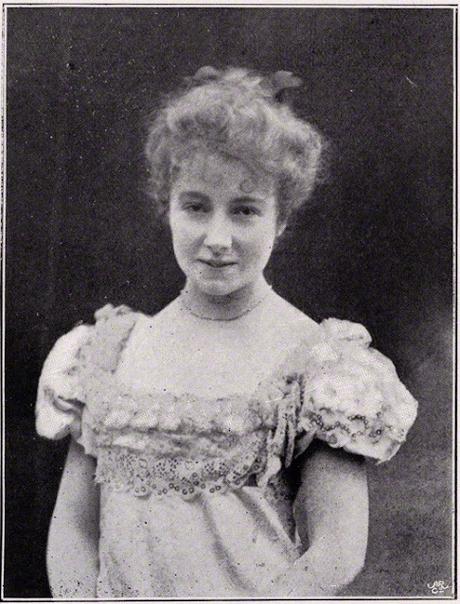
That's Ethel in around 1896, from a photo in the National Portrait Gallery by H S Mendelssohn. Now, I did wonder about this one by Arthur Hacker...

Syrinx (1892) Arthur Hacker
To be honest, Ethel looks like the sort of pretty late Victorian girl who crops up in lots of art of this period, much like Ethel Warwick, so it might be impossible to identify her in anything other than straight named portraits. Also, the way she completely fails to mention her modelling career indicates it was obvious a means to an end. Let's move on!
We might have one census return! In 1891, 'Ethel Wright' is living at Studio 9 on Elm Tree Road in Marylebone, London. Skipping neatly back to the Royal Academy catalog of 1888, Ethel's debut, we find that 'Miss E Wright' responsible for three paintings, was living at Woodbridge House, Elm Tree Road. Those paintings were His First and Only Love, Interrupted and Quirk. She was back in 1891 with the splendidly titled "And thrice he made to go, and thrice came back, so strong her beauty was - so large his love" Edwin Arnold 'Light of Asia', which has to be one of my favorite titles so far because you get your money's worth. 1891 also saw one of the weirdest reviews I have read, from the Illustrated London News - 'piquant Miss Ethel Wright, another young painter of the highest artistic promise and present prettiness. I do like these girls who are showing nowadays in such numbers that young women can be clever, cultivated and charming all at once!'
Lawks. Piquant.
Let's move swiftly (and piquantly) on to 1892 because the reason I wanted to bring Ethel to the Blogvent party is her clown pictures. Actually, being a girl of the 1980s, I got very excited about these. Let's start with number 1024 in the catalogue, "Bonjour Pierrot!"...
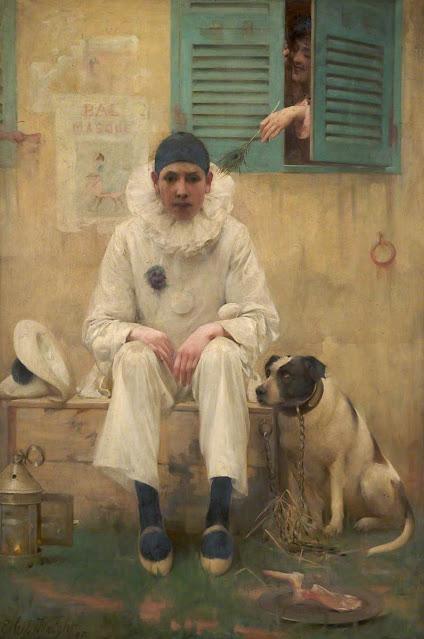
"Bonjour Pierrot!" (1892)
Yes, I am aware that pierrots and clowns are not exactly the same thing (I have never been road-raged by a Pierrot) (don't ask), but the whole melancholic figure of fun is very clown-y. They are just so damn elegant and beautiful. Don't judge me, I was raised to believe in the coolness of anyone who had Mira Fujita's wistful, androgynous pierrot on their bedding or stationary. For my '80s comrades, here's a quick reminder...
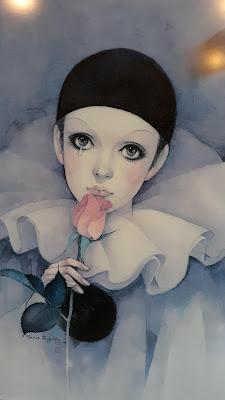
Still cool. Anyway, Ethel obviously agreed as she did a few...
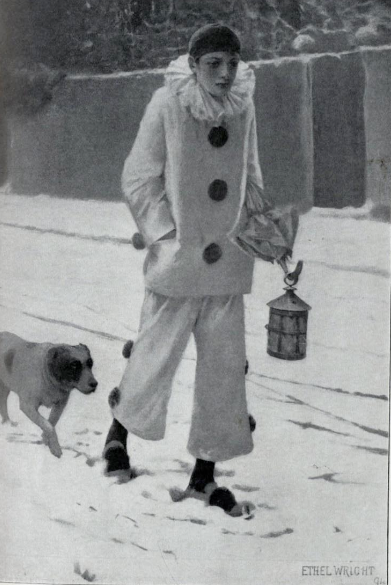
The Prodigal (1894)
Also, she did Pierrettes!
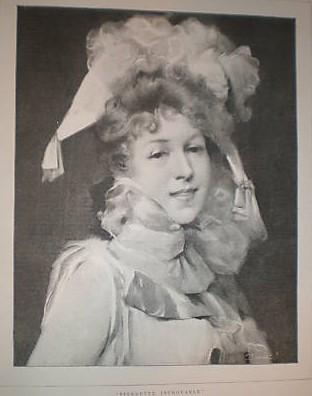
Pierrette Incroyable (1891)
Had I all the time in the world, I would do a proper dive into the many and varied art subjects of Miss Wright, but just for today I hold all my appreciation for the pierrots. They certainly made her name, as newspapers called her the artist behind "Bonjour Pierrot!" for many years following. It was noticed that the pierrot in The Prodigal was the same chap and the same dog, and an article on her in The Artist magazine of 1898 had reproductions of her pierrots. Even eight years later, the Queen magazine had "Bonjour Pierrot!" as a plate in 1899. Miss Wright however was moving into portraiture...
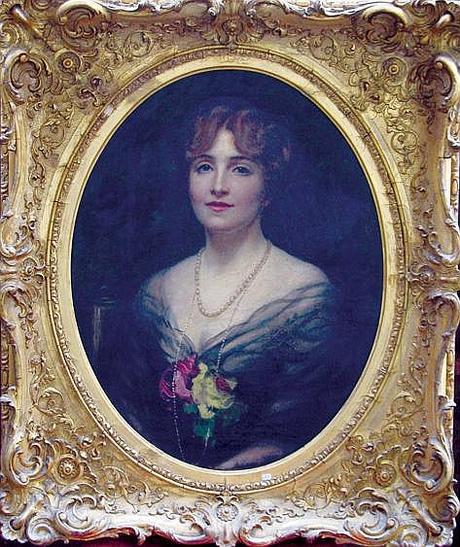
Portrait of an Unknown Woman (c.1896)
Of the three pictures she exhibited in the 1893 Royal Academy, two were portraits. One was Milly, daughter of Mr and Mrs D C Defries and the second was Lady Ada Osborne, daughter of the Duke and Duchess of Leeds. Interestingly, in the Autumn of 1895, the Bedford Daily Telegraph reported that Ethel had gone to stay with the Duchess of Leeds at Hornby Castle and Lady Ada had become her pupil. 1893 also saw a portrait of actress Olga Nethercote...
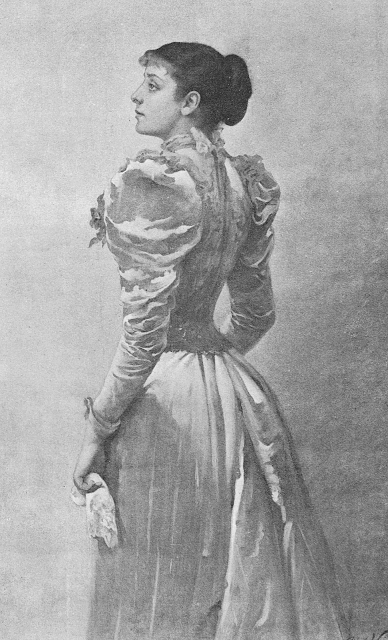
Olga Nethersole (1893)
Olga was arrested for indecency during a performance of the play Sapho (1900) as her character went up a staircase with a man and the inference was they were going to bed. The horror! And she invented extra long kissing on stage. Blimey.
1895 saw Susie, daughter of Capt the Hon John Yorke, but it also saw this corker...
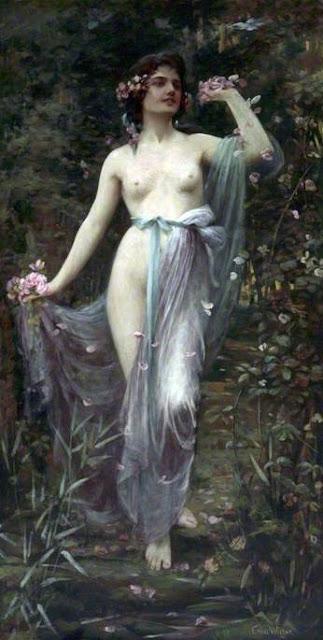
A Path of Roses (1895)
The picture was so popular that Charles Scarisbrick bought it for Stockport where it still lives in the Atkinson Art Gallery. In 1896, Ethel had two more paintings at the RA, Rejected and Portrait of a Lady. The year later, she exhibited Mrs Laurence Phillips, not far from Waterhouse's Hylas and the Nymphs. However, 1897 was also the year she got married to Bernard Arminger Berezinsky, a bit of a wrong 'un (to use a technical term). He had been convicted of larceny in New Zealand in 1881 and spent 3 months doing hard labor. When he married Ethel in Liverpool on 27th April 1897, Bernard was listed as a 'Theatrical Proprietor' living at the Adelphi Hotel in Liverpool. By this time, Ethel's father John had died, as had Bernard father Samuel, a school teacher. Nothing untoward seems to have happened to start with, although it became swiftly apparent that Bernard was not a theatrical proprietor, instead a jobbing journalist without any money. Ethel on the other hand was a rather well off, popular artist. There was a terrible fire at her studio in January 1899 and the large canvas she had worked on for 8 months was destroyed. It had been destined for the Royal Academy, but despite this set back and her ill-health, Ethel still managed to exhibit Mrs Arthur Strauss (the painting, not the lady).
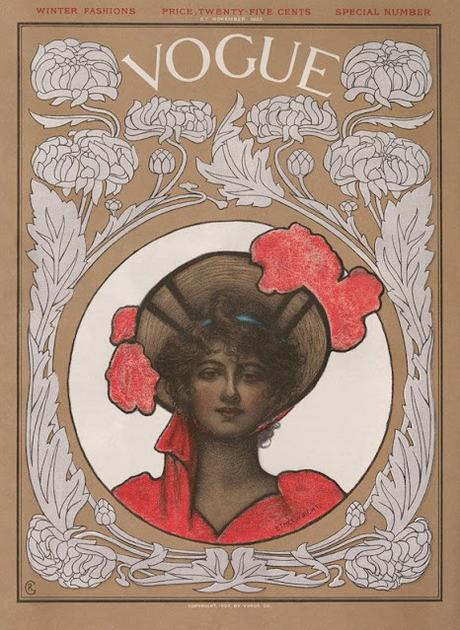
In 1902, she expanded her portfolio by designing the front cover to Vogue and a poster for the Success company in America...
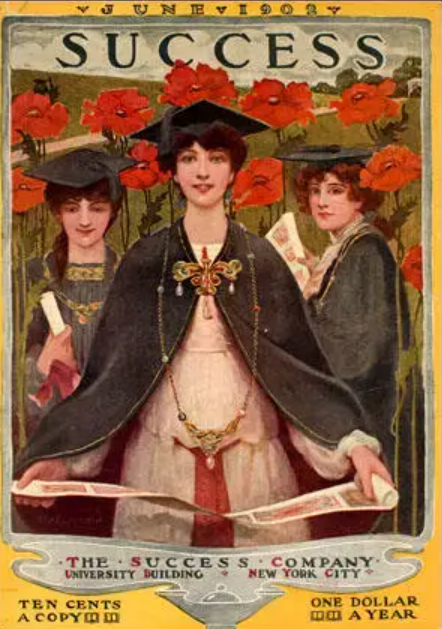
I find it really interesting in the 1908 article in Tatler, Miss Ethel Wright does not mention her husband. Partly, this is because he had left her in 1900, never to return. Ethel took herself off to America, passing judgment on their artistic skills. In the American Register in 1905, Ethel praised the skills of American illustrators who she considered to be superior to British ones, however she found that painting in America left a lot to be desired. The influence of European art was having beneficial effects (according to Ethel) and she found herself with lots of commissions for portraits - 'American women are splendid subjects. There is beauty, charm and brightness about them that fascinate the portrait painter.' She added 'The men are not so good.' Ouch.
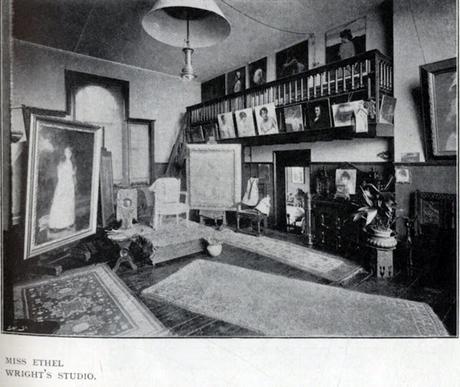
Ethel's Studio as seen in The Artist 1898
She was in America from around 1900 until 1905, and returned as a bit more of a celebrity, complete with her bohemian Chelsea studio where she met patrons and journalists. Much like Ethel Warwick, she petitioned her husband to return to the marriage, but he refused. There seems to have been no particular unpleasantness and even their letters to each other, kept in the divorce file, are exceptionally polite. I think it boiled down to the fact that she had money and he had none so provided her with no stability. I get the impression that she feared he was a fortune hunter or using her for clout. Her appeal for his return was couched in terms of his having a job and a place to live but he replied that she already had those things. He said that she had gone to America and it had gone wrong. She gained her divorce quietly in 1910 and he was never mentioned again.
I mention the marriage break up as I have seen it used as a reason why she turned to suffrage and feminism. I think there is a link but I think her ideas of equality and suffrage might not have appealed to her (is 'free-loading' too harsh? let's go with 'challenging') husband. Ethel knew her own mind, steered her own career and fell in with Suffragettes...
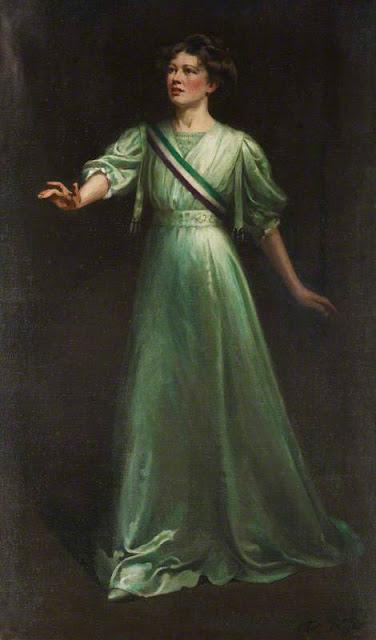
Christabel Pankhurst (1909)
I instantly recognised this image of Christabel Pankhurst as it is iconic, but what I didn't realize that it was rejected by the Royal Academy, causing a storm. Ethel held her own exhibition of it at her studio in Stafford Place, open to all members and friends of the WSPU. Instead of the picture going to the RA, it was exhibited at a 'women's exhibition', held at the Prince's Ice Rink in Knightsbridge. There, Ethel sold it for £100 and gave the money to WSPU. It was bought by Victor Duval, a suffragist who married Una Dugdale in 1912, to much scandal. The problem was that she announced that she would Love, Honour, but not Obey...
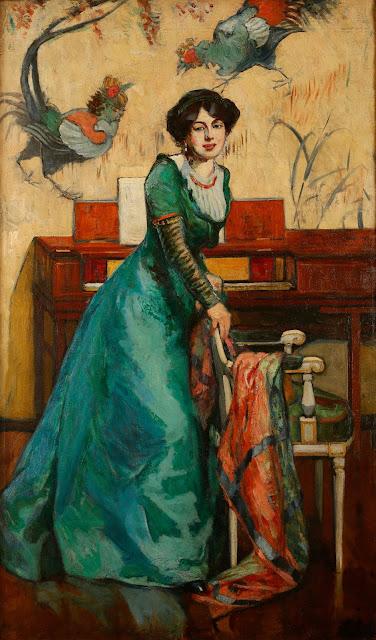
Portrait of Una Dugdale Duval (The Music Room) (1912)
Even worse, Victor was completely fine with her not obeying, but it was suggested that if Una didn't say 'obey' the marriage wouldn't be legal, which is utter bobbins. Una said the offending word (I didn't, Una, I'm with you Comrade!) but published a pamphlet on the subject, complete with a portrait by Ethel on the cover...
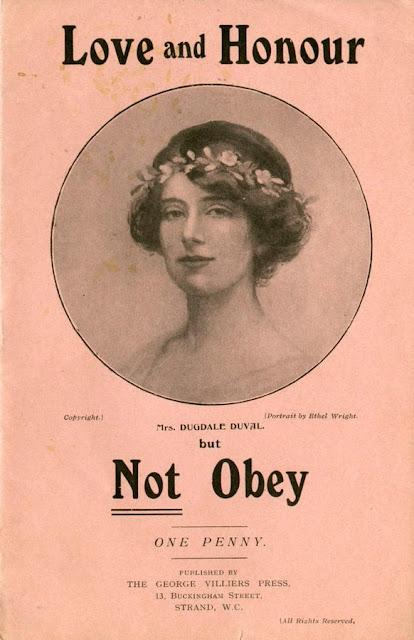
Right on, Sister! Ethel continued exhibiting for the next twenty-odd years, her art changing to embrace modern styles yet remaining essentially Ethel, striking and beautiful in equal measure.

A Bowl of Peppers (undated)
I'm going to have to draw this one to a close as I'll be here for ever. Ethel Wright is a fascinating subject, not least because she is so mysterious and even worse than Fanny Cornforth with her many and varied names. She died as Ethel Wright, just as Alice Wilding died as Alexa Wilding, and her probate record lists Ethel Wright dying on 6th July 1939 at 4 Earl's Terrace Kensington, leaving just over £3000. She missed out on being in my favorite census, the 1939 register, by a couple of months. Maybe if she had lived until October, a few of the questions about her origins might have been answered.
I'll leave you with an anecdote from Tatler about Ethel's antique collection. She had amassed quite a collection in her studio in Stafford Place, including a little plate made to celebrate the accession of William and Mary to the throne in the 17th century. She had seen the plate in a cottage in Ashford in Kent and so painted a picture of the cottage for the owner - 'I painted a rather dreadful picture ... in a couple of hours one morning when I was staying in the cottage. I purposely put in a tremendous amount of color which I expected to appeal to the owner of the cottage. When I showed her the painting she was delighted with it and I then offered to give it to her if she would give me the William and Mary plate, which she was delighted to do.' The article finishes with 'Miss Wright's artistic knowledge has enabled her to pick up a splendid bargain.' Marvellous
Goodness, I hope tomorrow's artist is less complicated...

